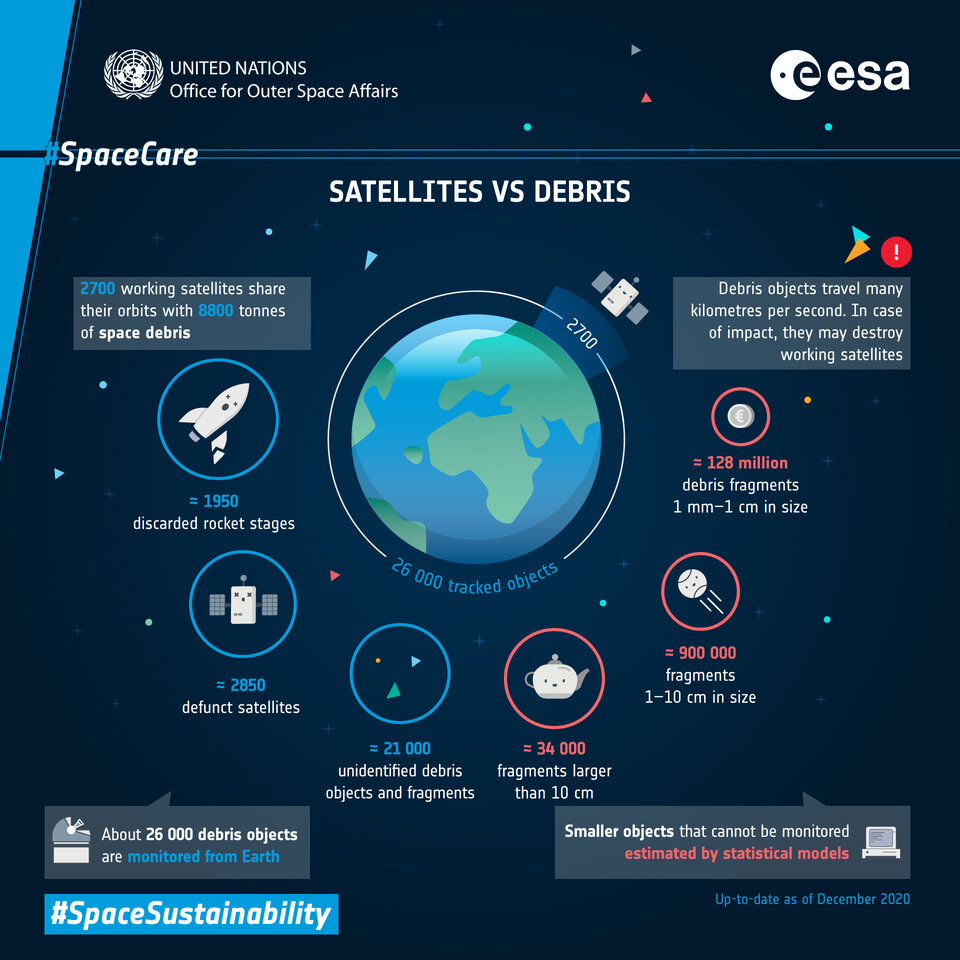11.02.2021

Space debris is an issue of global concern that threatens our continued use of near-Earth space for the benefit of humankind.
To raise awareness about this growing problem, ESA and the United Nations Office for Outer Space Affairs(UNOOSA) have created a series of nine infographics and podcast episodes that tell the story of space debris, explain the risks and illustrate the solutions available to ensure future space exploration remains sustainable.
A limited natural resource

Space may seem vast, but the orbits around Earth in which satellites reside are a limited natural resource. Accidental collisions, explosions and even the intentional destruction of satellites have created millions of debris fragments, which, orbiting at high speed, can damage or destroy any functioning spacecraft that crosses their path.
As satellite technology becomes ever more relied upon, it gets increasingly important to protect these unique orbital regions that are essential for humanity to, for example, gather data for weather forecasting and to better understand extreme weather and our changing climate, as well as for internet access, communication and location services.
A concern to all nations
Unfortunately, the amount of space debris in orbit is increasing at an exponential rate. As a growing number of countries and actors begin space activities – a hugely positive development in general – and as satellite operations become more complex and the number of objects being launched, including in large constellations, rapidly increases, so too do the challenges posed to our space environment.
In 2019, ESA’s Space Safety programme was adopted as a key pillar in the Agency’s activities. The programme, an expansion of the former Space Situational Awareness programme, includes ESA’s Space Debris and Clean Space Offices, which are working to better understand the debris environment, prevent the creation of more debris, reduce the amount in orbit and lessen the impact of space activities on Earth.
In 2018, the United Nations General Assembly expressed its worry about the fragility of the space environment and the impact of space debris, which is an issue of concern to all nations. In 2019, the United Nations Committee on the Peaceful Uses of Outer Space (COPUOS), of which UNOOSA is Secretariat, adopted the Guidelines for the Long-Term Sustainability of Outer Space Activities (LTS Guidelines), which provide guidance to help ensure the safe and sustainable use of space. The LTS Guidelines were subsequently welcomed with appreciation by the United Nations General Assembly, and a new working group will continue multilateral discussions on the topic.
Raising awareness
This new series of infographics jointly produced by ESA and UNOOSA include attractive, easy to understand illustrations, facts and figures so that everyone, with or without any previous knowledge of spaceflight, can understand space debris and the challenge it poses. They cover topics such as how debris is created, how to avoid collisions, the risk to humans in space from debris and on Earth from re-entries, as well as technologies for safe debris mitigation and removal.
Each of the nine infographics is accompanied by a podcast with audio commentary from ESA and UNOOSA experts, who help navigate and understand the material. Infographics and podcasts will be released here, once a week, over a period of nine weeks, starting on 10 February 2021, as well as via @UNOOSA and @ESA social media accounts.
"A new era of space has begun, in which large constellations of thousands of satellites are being launched to the skies," said ESA Director Jan Wörner.
"What this ‘New Space’ makes possible – global internet access, telecommunications – it also threatens, as a rapid increase in space traffic may dramatically increase the chance of collisions. Innovative technologies, responsible behaviour and importantly international cooperation are fundamental to ensuring our future in space is sustainable."
UNOOSA Director Simonetta Di Pippo said: "Space has its limits. Space debris poses a clear risk for the long-term sustainability of outer space activities. UNOOSA welcomes working with our partners at ESA to disseminate clear, accessible public information on space debris that will increase awareness of the challenges they pose and contribute to strengthening international cooperation on mitigation measures."
Quelle: ESA
